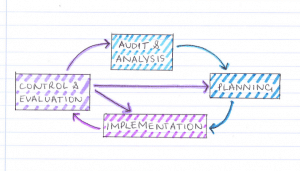What did we learn?
In the second week of our digital module we discussed the marketing planning process and why it’s an important part of marketing. In this lesson we also covered buying behaviour which varies with every customer.
We also took a look at how influencers can have an impact on the business, or customer/ consumer such as environmental, social and political.
The planning process
There are different approaches when it comes to marketing planning, and more than one model that you can use; but why exactly is planning so important? Planning is the fundamental element for identifying organisational direction, providing direction, ensuring that you can track and report on your objectives, ensuring that you cover all areas and finally, planning provides organisational focus.
Planning helps businesses get past day-to-day firefighting, and educates the whole team on company goals, as well as exactly where their role fits into.
The planning process should incorporate all of the below:</span
- Objectives – where we want to get to
- Analysis – internal and external factors that could affect your business
- Strategy – how are we going to get there
- Action plan/ tactics – what we need to do to be able to get there
- Timing – time scales of goals and objectives
- Resources – the resources we need to achieve your goals, including budget
Some marketing planning will be carried out in stages, such as the action planning. Another approach to planning is cyclical, the cycle time will vary depending on the task, an example of cyclical planning is the SOSTAC model</span.
Planning model: APIC
APIC is a model that takes a cyclical approach, it varies slightly from the SOSTAC model. It’s four stages stand for:
- Audit and analysis – identifying strengths and weaknesses, incorporating both external and external (macro and micro) influences. This section is also used to examine the businesses strengths and weaknesses, a SWOT tool can be used for this.
- Planning – this stage sets out the target results that you will later audit on, these should relate to corporate goals. While also including your tactics, schedules, budgets, and specific marketing activities.
- Implementation – this is where you deliver on the plan and discuss marketing and promotional mix. The success of this stage is dependent on a good ‘audit and analysis’, and success is measured in the last ‘control’ stage.
- Control (Evaluation) – the very stage involves measuring the overall success of meeting goals and objectives.
Customer and consumer buying power
A key part of marketing is spent evaluating your customers and prospects. Marketers are really trying to understand their customers buying behaviour – here’s why you should be paying attention too:
Deliver more appropriate and relevantly: Understanding your customers wants, needs, and what influences them is key. You can then begin to develop an understanding of what platforms they are using and meet your customer where they already are. If you know your customers, it means that time isn’t wasted on content that isn’t going to move your target audience closer to the end of the funnel.
Higher customer satisfaction: Marketing campaigns that deliver relevant content, will mean that prospects will have a higher interest in what their reading. From this, it will make it a better experience for the customers, but also improve the effectiveness of the campaign.
Better customer/ business relationship: A customer who feels that a business understands what they really want, will hold a better relationship and encourage returning customers. Knowing your target audience also means knowing how they prefer to communicate. Whether customers prefer to make a purchase decision based on reviews or based on ad that popped up at the right time, this is something that you may need to consider.
Customer Influences
There are many variables that are not controlled by marketers but can have an influence on their purchase decision, such as their age, or lifestyle differences. Below are some of the biggest influences to be aware of:
Psychological influences
- Attitudes and beliefs
- Perception
- Motivation
- Learning
Social and cultural influences
- Groups
- Culture
Personal factors
- Demographics (e.g. age, job, location)
- Personality
- Propensity towards risk (how likely are they to take a financial, performance, physical, social, ego, or time risk when making the decision to purchase a new product?)
- Behavioural economics
Business influences
Similar to customers, businesses also have influences that play an important role within the spectrum of buying behaviour. These influences are:
Environmental factors
- Economic climate
- Technological
- Political
- Cultural
- Social factors – especially for global companies dealing with lots customers from different backgrounds
Organisational
- Policies
- Performance evaluation
- Internal hierarchy/ status
Group or interpersonal factors
- Group dynamics within a team, teams are often not static and therefore will affect how they influence each other ion joint decision making
Individual factors
- Personal factors including age, and an individual’s opinions will affect the direction the company goes in, at the end of the someone will make the final call
When a decision has an outcome that affects a large amount of people, there’s no surprise in the number of factors we are seeing here! The more complex decisions become, the more people are involved, and the more data is analysed.
Author
-
Emily joins the Napier Team as a digital marketing apprentice, with the support of Chichester College. Emily recently completed her A-levels in Fine Art, Photography and English Language.
View all posts

